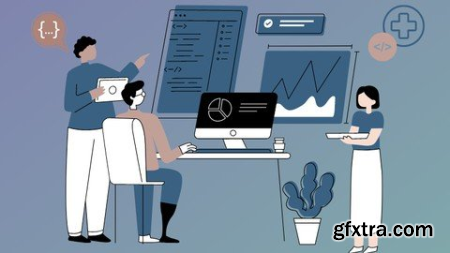
Published 2/2023MP4 | Video: h264, 1280x720 | Audio: AAC, 44.1 KHzLanguage: English | Size: 2.01 GB | Duration: 5h 28m
Learn real-world skills such as Xgboost(GBT), Sklearn , Random-Forest, HyperOpt, Docker, FastAPI in under 6 hours What you'll learn Use Python for Data Science and Machine Learning Learn to use Pandas for Data Analysis Random Forest and Decision Trees Learn to use Seaborn for statistical plots Implement Machine Learning Algorithms Learn to use Matplotlib for Python Plotting Multivariate Regression HyperOpt Machine learning optimization K-Means Clustering Principle Component Analysis Keras Tensorflow Models Evaluate different types of Machine learning models FastAPI Docker Deploying your models Requirements Some programming experience Description Are you interested in applying your data science and machine learning skills to a real-world healthcare challenge? Do you want to learn how to develop accurate models for healthcare projects, such as predicting patient length of stay in hospitals using cutting-edge tech tools and frameworks like pandas, Sklearn, random forest, xgboost, TensorFlow, and Docker? Then our "Get Job-Ready with our Practical ML and Data Science Course" is the perfect opportunity for you!Through this hands-on course, you will gain experience with various tech tools and frameworks, including pandas for data manipulation, sklearn for modeling, xgboost for gradient boosting, TensorFlow for deep learning, and Docker for deployment. You'll also learn how to use FastAPI to create efficient and scalable web applications.The course is structured in the following way:Section 1: We will cover the Basics of Machine learning and introduction to many of the technologies to be applied in this courseSection 2: We will cover establishing our business case for the project, perform data ingestion and data preprocessing Simple and Multiple Linear regression, univariate and multivariate analysisSection 3: We will cover K-means clustering, PCA(Principle component analysis), and outlier/anomaly detection methodsSection 4: We will develop various machine learning models such as decision trees, random forest, xgboost ,lightbgm and deep neural networks Section 5: We will cover the deployment of created models using Docker/FastAPI and will create an efficient and scalable API using FastAPI. You'll also learn how to test and optimize your model to ensure that it meets the performance requirements. By taking the course, you will also have the opportunity to build your portfolio of real-world healthcare projects to showcase your skills to potential employers.By the end of the course, you'll have gained the confidence and practical skills you need to land your dream job in machine learning and data science and to make a real impact in the healthcare industry. So why wait? Sign up for our "Get Job-Ready with our Practical ML and Data Science Course" today, and start your journey to success! Overview Section 1: Introduction Lecture 1 Introduction Lecture 2 How to take the course Lecture 3 Python recap Lecture 4 Jupyter Notebooks and Google Collaboratory Lecture 5 Github and Codespaces Section 2: Basics of Machine Learning Lecture 6 Intro to this section Lecture 7 Machine Learning Basics - 1 Lecture 8 Machine Learning Basics - 2 Lecture 9 Machine Learning Stages - 1 Lecture 10 Machine Learning Stages - 2 Lecture 11 Intro to tech stack for the project - 1 Lecture 12 Intro to tech stack for the project - 2 Section 3: Project Preliminary Data Analysis Lecture 13 What we will cover in this section Lecture 14 Machine Learning for health care sector Lecture 15 Business case for our project Lecture 16 Data Ingestion - 1 Lecture 17 More on AWS resources Lecture 18 Data Ingestion - 2 Lecture 19 Data Ingestion - 3 Lecture 20 Data Summary and data types Lecture 21 Working with dates Lecture 22 Modelling the target variable Lecture 23 Categorical Encoding Lecture 24 Univariate analysis Lecture 25 Handling Missing data Lecture 26 Linear Regression Basics - 1 Lecture 27 Linear Regression Basics - 2 Lecture 28 Bivariate and regression analysis Section 4: Project Advanced Data Analysis Lecture 29 What we will cover in this section Lecture 30 K-Means Clustering theory(Optional) Lecture 31 K-means clustering - 1 Lecture 32 K-means clustering - 2 Lecture 33 Outlier Analysis Lecture 34 Data Leakage Section 5: Building ML Models Lecture 35 What you will cover in this course Lecture 36 Ensemble Methods Basics - 1 Lecture 37 Ensemble Methods Basics - 2 Lecture 38 Decision Tree and Random Forest Lecture 39 Evaluating Random Forest Models Lecture 40 HyperOpt - Optimization of hyper parameters Lecture 41 Partial Dependency Plots Lecture 42 LightGBM Lecture 43 Sklearn Pipeline Lecture 44 XGboost Lecture 45 Neural Networks Section 6: Model Deployement Lecture 46 What we will cover in this section Lecture 47 Getting started with deployment Lecture 48 Writing our production code Lecture 49 Writing our FastAPI server Lecture 50 Docker Getting started Lecture 51 Docker implementation - 1 Lecture 52 Docker implementation - 2 Students and Professionals wanting to learn and advance their machine learning skills and get job-ready skills HomePage:
Top Rated News
- Sean Archer
- AwTeaches
- Learn Squared
- PhotoWhoa
- Houdini-Course
- Photigy
- August Dering Photography
- StudioGuti
- Creatoom
- Creature Art Teacher
- Creator Foundry
- Patreon Collections
- Udemy - Turkce
- BigFilms
- Jerry Ghionis
- ACIDBITE
- BigMediumSmall
- Boom Library
- Globe Plants
- Unleashed Education
- The School of Photography
- Visual Education
- LeartesStudios - Cosmos
- All Veer Fancy Collection!
- All OJO Images
- All ZZVe Vectors




